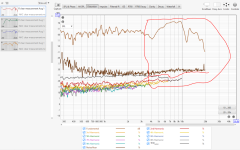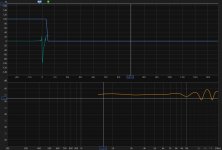Please post the impulse response for the first 2ms of just the tweeter if possible.
Baffle diffraction does not cause sustained ringing, is it possible the tweeter is missing the damping material in the rear chamber?
Baffle diffraction does not cause sustained ringing, is it possible the tweeter is missing the damping material in the rear chamber?
What could be happening is the baffle step is reflecting a 16KHz off-axis resonance into the listening axis.
Try filling in the crevice at the baffle step with clay or just a sloppy application of tape. Also try using tape to square up the beveledge edge of the step, which is the right angle to reflect something toward the listener.
Try filling in the crevice at the baffle step with clay or just a sloppy application of tape. Also try using tape to square up the beveledge edge of the step, which is the right angle to reflect something toward the listener.
I'm thinking of attaching a board in front of the tweeter that will act as a waveguide.
BTW the impulse response looks a bit swingy. Maybe that causes the weird ringing?
But on the other hand that will impact the overal tweeter response not only certain frequencies.
BTW the impulse response looks a bit swingy. Maybe that causes the weird ringing?
But on the other hand that will impact the overal tweeter response not only certain frequencies.
The swinging in the impulse response IS the ringing, the impulse response is the same data that is in the frequency response, but displayed in the time domain instead of the frequency domain. Anything that is visible on the frequency response can be found in the impulse response, but each makes it easier to see different things. Use the EQ tab in REW to add notch filters (negative PK filters) to remove the ringing, then you can more easily see the other things like reflections and diffraction.
In order to get a good baseline, why don't you remove the tweeter from the baffle and measure it alone without anything close around?
Then you will know if the ringing comes from the baffle or not.
Then you will know if the ringing comes from the baffle or not.
Thank you for your advice.Use the EQ tab in REW to add notch filters (negative PK filters) to remove the ringing, then you can more easily see the other things like reflections and diffraction.
Sorry but I have never used EQ feature in REW. Even more I have no idea how to use it Looka very promising but will takes some time to explore it.

Last edited:
Look waterfall in first post, it shows ringing until 20 -30 ms, impulse response on image is only to 3 ms.The swinging in the impulse response IS the ringing, the impulse response is the same data that is in the frequency response, but displayed in the time domain instead of the frequency domain. Anything that is visible on the frequency response can be found in the impulse response, but each makes it easier to see different things. Use the EQ tab in REW to add notch filters (negative PK filters) to remove the ringing, then you can more easily see the other things like reflections and diffraction.
As I remember levels were 68dB SPL and I didn't change the settings between woofer and tweeter measurements.
However the process is not reversible. If an impulse containing excess-phase information is "flattened" to a response plot, it loses information that cannot be recovered.Anything that is visible on the frequency response can be found in the impulse response, but each makes it easier to see different things.
For an impulse to be correct it needs to be directly recorded and preserved that way.
“The first step in looking at any speaker system, is to take nearfield measurements of the individual driver outputs. This tells you what the driver is doing and removes almost all of the room acoustics effects and some of the cabinet affects. Doing anything else first is a waste of time”
Jack Hidley
Put your mic up at close to the tweeter as possible Eg. 2mm and re-measure.
Jack Hidley
Put your mic up at close to the tweeter as possible Eg. 2mm and re-measure.
Then why does the group delay and step response not show an obvious noise source? It does look a bit like the woofer crossover is not connected, perhaps?
Here is the step response with some peak filters. You can remove ringing and then you are left with reflections.
Target settings -> none, then click the EQ filters button at the top and add some PK filters. With the filters we can clearly see reflections at 250us and 500us (3.4 and 6.8 inches).

Here is the step response with some peak filters. You can remove ringing and then you are left with reflections.
Target settings -> none, then click the EQ filters button at the top and add some PK filters. With the filters we can clearly see reflections at 250us and 500us (3.4 and 6.8 inches).
Attachments
keep in mind that a waterfall doesn't necessarily show long ringing. It shows the latest time after the beginning that a contribution to the output (at each frequency) happens. If something contributes energy a msec or so after the main impulse, you'll see a ridge going out to that msec plus whatever real ringing on top of that. By 'something' I mean, of course, a reflection like that cabinet shown in the photo.
As interesting as REW is, I still don't see a smoking gun.
The way I understand this problem is, we are trying to rule out any other cause before trying to convince the tweeter manufacturer that it is defective.
Measuring the tweeter on it's own is a good idea, but measuring a tweeter without a baffle might be even more confusing. I would mount it on a big piece of cardboard or foam.
Adjusting the windows, we can see that before the first reflection the impulse response is pretty much pristine.

The first reflection at 250us causes comb filtering at 16KHz

The next reflection after that causes comb filtering throughout the upper mids and treble.

However scanning backwards through the step response with a short FDW window, we find that there is a sustained ringing at 15KHz which overlaps with the comb filtering, but they are two separate mechanisms.

So the tweeter is definitely ringing, and the baffle seems to be reinforcing it. If you change the tweeter position you could possibly get the ringing to land in a diffraction null instead of a peak. To know whether there is anything wrong with the tweeter itself you would have to test it in another baffle or possibly without the mounting plate, but I wouldn't blame the tweeter yet although the ringing is concerning.
The way I understand this problem is, we are trying to rule out any other cause before trying to convince the tweeter manufacturer that it is defective.
Measuring the tweeter on it's own is a good idea, but measuring a tweeter without a baffle might be even more confusing. I would mount it on a big piece of cardboard or foam.
Adjusting the windows, we can see that before the first reflection the impulse response is pretty much pristine.
The first reflection at 250us causes comb filtering at 16KHz
The next reflection after that causes comb filtering throughout the upper mids and treble.
However scanning backwards through the step response with a short FDW window, we find that there is a sustained ringing at 15KHz which overlaps with the comb filtering, but they are two separate mechanisms.
So the tweeter is definitely ringing, and the baffle seems to be reinforcing it. If you change the tweeter position you could possibly get the ringing to land in a diffraction null instead of a peak. To know whether there is anything wrong with the tweeter itself you would have to test it in another baffle or possibly without the mounting plate, but I wouldn't blame the tweeter yet although the ringing is concerning.
Attachments
Last edited:
- Home
- Loudspeakers
- Multi-Way
- Strange SB tweeter ringing


